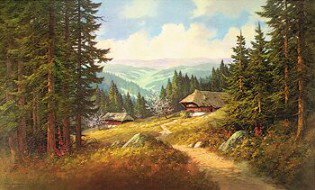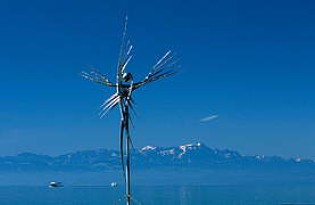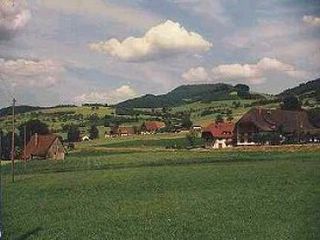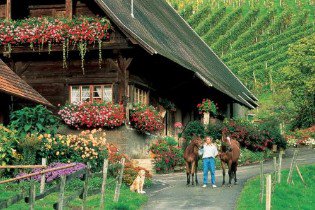The economic and intellectual center of southwest Germany not only lies at the foot of the Black Forest, 278 meters above sea level and surrounded by a fertile mountainous landscape, but it is also situated in the "three country corner" where Germany, Austria and Switzerland touch.
Around 28 million overnight stays per year in 138,000 beds in hotels and guest houses and a further 60,000 private rooms underline the importance of tourism for the Black Forest, and the wine regions of the south west.
The Black Forest enjoys the highest density of restaurants with top chefs, and even in the small village restaurants the entire selection of the hearty regional cuisine can be enjoyed in many of its delicious variations.
The Black Forest enjoys the highest density of restaurants with top chefs, and even in the small village restaurants the entire selection of the hearty regional cuisine can be enjoyed in many of its delicious variations.
Thermal baths like Baden-Baden, Badenweiler, Bad Wildbad have a long tradition. Such a wealth of thermal springs can be found nowhere else in such close proximity.
The countryside to the south is well known for its hot springs at Badenweiler and for the many frescoes in the churches of Markgraflerland. "Baden cuisine" and wine-making villages are to the west.
The countryside to the south is well known for its hot springs at Badenweiler and for the many frescoes in the churches of Markgraflerland. "Baden cuisine" and wine-making villages are to the west.
The Black Forest covers an area of over 400 square miles. Its name conveys an image of dense tangled forest, but nothing could be further from the truth.
The area is wooded but there are also vast open tracts of undulating hills peppered with attractive traditional villages and half-timbered houses.
Hiking the Black Forest
With or without luggage, with hiking boots or trainers, carbon sticks or telescope rods - no other mountain range has a more professional and varied range of attractions on offer than the Black Forest.
Nearly all trails in the hiking regions of Germany are extremely well-marked and maintained. Via a mountain ridge path, hikers can reach the highest point of the Northern Black Forest, which is Mount Hornisgrinde.

Beautiful cirque lakes, such as Mummelsee or the secluded Wildsee, line the route.

If you continue along this route, you will come past the European watershed, between the rivers Rhine and Danube.

This part of the route offers superb views across the deep valleys of the Western Black Forest and the flat high-lying valleys in the east.
The bare hilltops of the Feldberg area represent a kind of "sub alpine island in the low mountain range", offering a habitat for many plants of the Ice Age.
The bare hilltops of the Feldberg area represent a kind of "sub alpine island in the low mountain range", offering a habitat for many plants of the Ice Age.

Marmots, wild boars, and the occasional deer are common as well, but most wildlife has been driven to non- existence by hunting rights, disease, and in the name of forest protection.

Nowadays, you’re more likely to be confronted with a curious-looking sheep or cow than anything else.

There are many fine open ridge walks that afford grand views over forest, pasture and mountain lakes.

The pine and birch studded mountains here are alive with fairy-tale villages, well-equipped spas, and modern ski resorts.

In no other country is Christmas more elaborately and universally celebrated. The Christmas season officially begins with the beginning of Advent, four Sundays before Christmas Day.

The tradition of the Advent wreath, a circle of greenery in which four candles are set, originated with the German Lutherans. One candle is lit the first Sunday of Advent, two are lit the second Sunday, and so on until the fourth Sunday.
A large white candle in the center is lit on Christmas Day. The Advent calendar, an elaborate calendar with windows used to count down the days until Christmas, also originated in Germany.
The Christmas Tree owes its widespread popularity to Germany. In the Middle Ages the Germans would put on a mystery play each December 24th, the feast day of Adam and Eve.
The plays invariably featured a decorated evergreen which represented the Tree of Life from which Adam and Eve ate and as a result were banished from the Garden of Eden.
A large white candle in the center is lit on Christmas Day. The Advent calendar, an elaborate calendar with windows used to count down the days until Christmas, also originated in Germany.
The Christmas Tree owes its widespread popularity to Germany. In the Middle Ages the Germans would put on a mystery play each December 24th, the feast day of Adam and Eve.
The plays invariably featured a decorated evergreen which represented the Tree of Life from which Adam and Eve ate and as a result were banished from the Garden of Eden.

Over the centuries the plays and associated festivities strayed from their religious origins and the Church ceased to sponsor them. But the people continued to set up and decorate a tree in their home every year at Christmas.
In 1880 glassmakers in Germany discovered how to make blown glass balls and bells, which became the decorations used to trim Christmas trees all over the world. St. Nicholas has traditionally brought gifts to German children on the eve of his feast day, December 6.
In 1880 glassmakers in Germany discovered how to make blown glass balls and bells, which became the decorations used to trim Christmas trees all over the world. St. Nicholas has traditionally brought gifts to German children on the eve of his feast day, December 6.

St. Nick is today is increasingly known as Father Christmas throughout Germany and appears not on St. Nicholas Day Eve, but on Christmas Eve.
In Germany, as in many European countries, the highpoint of the Christmas season is Midnight Mass on Christmas Eve. A midnight service is celebrated by both Catholics and Protestants.
Thickly wooded and, for centuries, isolated and mysterious, people called this the Black Forest (Schwarzwald.) Now, rather than black, it's a bright and sunny vacation land. But even today, in remote villages and farmsteads, local dialects survive and traditions are strong.
In Germany, as in many European countries, the highpoint of the Christmas season is Midnight Mass on Christmas Eve. A midnight service is celebrated by both Catholics and Protestants.
Thickly wooded and, for centuries, isolated and mysterious, people called this the Black Forest (Schwarzwald.) Now, rather than black, it's a bright and sunny vacation land. But even today, in remote villages and farmsteads, local dialects survive and traditions are strong.

The Black Forest, rich and dense, beautiful and serene, is the stuff of legends, and has been the inspiration for many of the world's most beloved fairy tales.

It was here that little Hansel and Gretel got lost and stumbled upon the ghastly witch and her gingerbread cottage. No doubt, Little Red Riding Hood and a host of others were drawn from the dark depths of the Schwarzwald as well.

Christmas in the Black Forest of Germany is a time for special crafts, candles, scents, spiced wines, gingerbread, roasted goose, smoked ham, special cheeses, spiced fruits, and cakes, and candies, and chocolates, and pastries, and decorations.

Germans build up to Christmas gradually, starting their celebration on Saint Martin'sDay, the eleventh of November. This feast day honors a Roman soldier who shared his cloak with a shivering beggar.

The impoverished man was actually the disguised Christ according to the wonderful legend. The tradition of gift giving, as exemplified by the concerned saint, has continued to this day, much to the delight of youngsters who are the principal beneficiaries of all the goodies.

On that day, as well, children carry lanterns and torches through the winding village streets. At night, high on the hills over the towns, they will light fires; the blazes, signifying light and hope in the advent of winter, can be seen for miles.
Next comes Saint Nicholas Day on the sixth of December, another holiday expressly for children who again receive gifts of fruit and candy.
From the Saint Nicholas character, which probably stems from a medieval king figure, we in the United States get our own Santa Claus with his white beard and elaborate red costume.
Next comes Saint Nicholas Day on the sixth of December, another holiday expressly for children who again receive gifts of fruit and candy.
From the Saint Nicholas character, which probably stems from a medieval king figure, we in the United States get our own Santa Claus with his white beard and elaborate red costume.

The German Nicholas rides about on a great white horse, followed by his grimy and grumpy manservant who usually goes by the name of Ruprecht.
This character hands out gifts to the good youngsters and punishes the bad ones, including-supposedly-dipping them into a giant ink pot!
The annual Christmas market opens early in December, offering for sale almost every imaginable holiday item from candles to candy.
Many town centers are crammed with tiny stalls dis-playing oodles of decorations, trees, baked goods, and similar delights.
This character hands out gifts to the good youngsters and punishes the bad ones, including-supposedly-dipping them into a giant ink pot!
The annual Christmas market opens early in December, offering for sale almost every imaginable holiday item from candles to candy.
Many town centers are crammed with tiny stalls dis-playing oodles of decorations, trees, baked goods, and similar delights.

If you can't find a present here, you just haven't looked long enough! Youngsters love wandering from booth to booth in these Christmas fairs or "Christ Child markets," as they are sometimes called. Many markets date from the 1300s.
As the time gets closer to Christmas, the weather turns colder. The markets become quiet, almost hushed, as the vendors huddle over their tiny coal-fed fires. Last-minute shop-pers are the same anywhere as they rush around stocking up on wares.
As the time gets closer to Christmas, the weather turns colder. The markets become quiet, almost hushed, as the vendors huddle over their tiny coal-fed fires. Last-minute shop-pers are the same anywhere as they rush around stocking up on wares.

For the child who plans ahead, a list of wishes is a must. Childrens notes are often addressed to Father Christmas or to the Christ Child and are gaily decorated with bright illustrations. The feeling is that the better the drawings, the more gifts are forthcoming.
All the stores close promptly at one in the afternoon on Christmas Eve as everyone hurries home to put on their best clothes and sit down to a magnificent supper. While the children are eating, the parents slip the pres-ents under the tree in the front room.
All the stores close promptly at one in the afternoon on Christmas Eve as everyone hurries home to put on their best clothes and sit down to a magnificent supper. While the children are eating, the parents slip the pres-ents under the tree in the front room.

As soon as the first church bells sound the call to Vespers, an evening prayer service in the Catholic districts of Germany, the head of the house rings a tiny bell to tell everyone that Father Christmas has arrived.
The youngest child has the lucky duty of opening the door to the room with all the presents. The resulting scene as everyone crowds around the tree is best left to the imagination!
The youngest child has the lucky duty of opening the door to the room with all the presents. The resulting scene as everyone crowds around the tree is best left to the imagination!

Even with all the gift giving and the huge meals, the true spirit of Christmas is never forgotten. Both Catholic and Protestant faiths offer midnight services in the country's great cathedrals and tiny village churches.
The sounds of carols flow over the wintry country-side as easily as new fallen snow.
The sounds of carols flow over the wintry country-side as easily as new fallen snow.

Everything is awash with light because many parishioners bring their own candles and lanterns to church. It is traditional to keep silent on the way to the Christmas liturgy, but once the services are over, everyone explodes with holiday greetings.
Then it's home to bed and dreams of toys and sugarplums.Festive meals round out Christmas Day, and more gifts are exchanged as relatives and friends drop by to say hello and offer holiday greetings.
Then it's home to bed and dreams of toys and sugarplums.Festive meals round out Christmas Day, and more gifts are exchanged as relatives and friends drop by to say hello and offer holiday greetings.

In the center of all this hubbub stands the Christmas tree, one of the best exports that Germany had for the rest of us. Candles are still used to decorate the silver or blue spruce that seems to be most popular.
Giant firs stand outside public buildings, decorated by means of firemen's ladders. Offices and homes seem to outdo each other with their decorations. In several places, living trees are given the honor of being the community's official Yule tree.
Giant firs stand outside public buildings, decorated by means of firemen's ladders. Offices and homes seem to outdo each other with their decorations. In several places, living trees are given the honor of being the community's official Yule tree.

So from gift giving to marzipan to beautiful carols, Germany has long given treasured cus-toms to the rest of the world. Even after a full and happy Christmas Day, the festivities don't end. There's Saint Stephen's Day to celebrate on the twenty-sixth of December, leading into the Holy Twelve Nights that extend to Epiphany, the Feast of the Three Kings, on the sixth of January.

Germans simply don't want Christmas to slip away from them, but as the days grow longer and the late winter melts into spring, they eventually turn their thoughts to other holidays. Always, in the back of their minds, however, are the dreams of the next year's Christmas.

Black Forest Special Info ...
*Special Black Forest Video
*The Adventures of BJ and Tony Morris Black Forest, Germany
*The Heart of the Black Forest
*Recipes From a German Grandma
*German Foods & Crafts & Gift Links
*German Bread & Dessert Recipes


The Black Forest has a network of paths, trails and country roads for sport and adventure travel, which cover more than 14,300 miles (23,000 kilometers).

The peaks in the southern part of the forest reach as high as 1,525m (5,000 ft.) and are excellent for skiing in winter and hiking or mountain climbing in summer. Fish abound in the streams and lakes.

Link ...
*Black Forest Germany






The first travelers checked in here 19 centuries ago, when the Roman emperor Caracalla and his army soothed their battle wounds in the natural-spring waters at what later became Baden-Baden.

In the 19th century just about everyone who mattered in Europe gravitated to Baden-Baden: royalty, members of Napoléon's family, and the Russian nobility, along with actors, actresses, writers, and composers. Turgenev, Dostoyevsky, and Tolstoy were among the Russian contingent.

Victor Hugo was a frequent visitor. Brahms composed lilting melodies in this calm setting, and Mark Twain waxed poetic on the forest's beauty in his 1880 book "A Tramp Abroad."
Winter Sports Black Forest Germany

The Black Forest is the cradle of skiing and snowboarding! Folks like to tell the story of the early ski enthusiasts who established the oldest ski club in Germany in 1895 which still exists today.

Those who bring some extra endurance along with them can try hiking 100 kilometers on their skies, from Shonach to Belchen, if they dare. And for those who only want to watch, there are live international competitions!

Highlights are the Black Forest backpack run, where participants endure the 100 kilometers from Schonach to Belchen for the World Cup, and the ski-jumping tournaments in Schönwald and Neustadt.

Southern Black Forest Area (Bodensee)
Special Info ...
*Mainau Island

















































































































































2 comments:
Wondrous and amazing! Thank you ~}!{~
Awesome pics, makin me want to move already!
Post a Comment